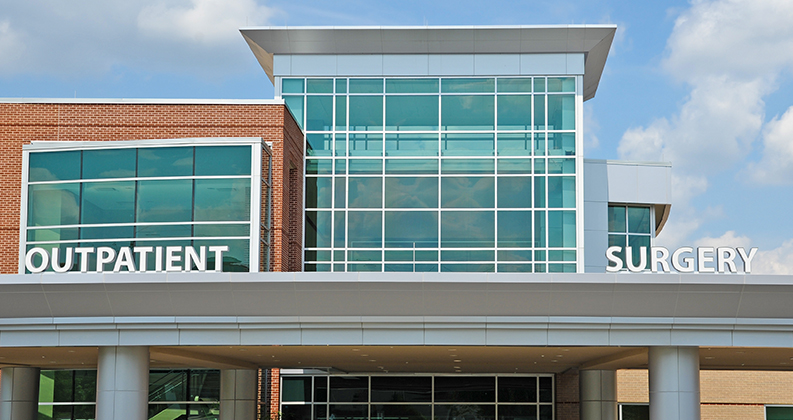
Ambulatory surgery centers (ASCs) thrive on streamlined workflows to provide cost-effective and efficient patient care. The value proposition of performing orthopedic procedures in ASCs appeals to surgeons who want to operate in specialized facilities, insurers that want to pay less for high-quality care and patients who want to recover in the relative comfort of home.
These market forces are pushing more cases to outpatient settings. Consider the following trends:
- Orthopedic facilities account for 37% of Medicare-certified ASCs, the highest percentage among surgical specialties, according to the ASC Association.
- The ASC Association also notes that orthopedic surgeries are performed at nearly 70% of Medicare-certified multi-specialty ASCs. Again, the highest percentage among all specialties.
- The 2022 Annual Report of the American Joint Replacement Registry (AJRR) noted that more than 22,000 joint replacements were performed in freestanding or hospital-affiliated ASCs in 2021. That’s 57% more since the previous AJRR’s annual report.
- ASCs will perform an estimated 68% of orthopedic surgeries by the mid-2020s, according to a report by ResearchandMarkets.com.
The outpatient orthopedic market continues to gain momentum and is impacting how device manufacturers develop new products and bring them to market.
Andrie Leday, Vice President of the ASC Division at DePuy Synthes, said the designs of the company’s joint reconstruction, trauma, sports medicine, spine and enabling technologies are based in part on the current shift in the site of surgical care.
“As we consider quality patient outcomes, it’s important to develop solutions that work in ASCs,” he said. “We recognize the value that smartly designed devices have on patient outcomes.”
Leday said products intended for use in the ASC need to be affordable and designed with smaller footprints and intuitive user interfaces. “Flexibility and agility are important to ASC customers,” he added. “They make decisions more rapidly and appreciate working with manufacturers that are creative in meeting their needs. We provide flexible pricing options to get new technology into their hands based on their budget size.”
Ben Joseph, Anika Therapeutic’s Vice President of Commercial and Corporate Development, said new products must deliver value for everyone involved in getting them into ASCs, including surgeons, distributors and sales reps. “The logistics and finances need to make sense for all stakeholders,” he added. “That’s why we strongly consider the voice of customers in the development of new products.”
Shoulders Show Growth Potential
Current industry estimates suggest approximately 200,000 shoulder arthroplasty procedures will be performed in the United States this year. Shoulder replacements are also projected to grow at an 11% Compound Annual Growth Rate (CAGR) through 2026.
“The shoulder is a big driver of care in the ASC,” Joseph said. “It’s a fast-growing segment and we’re excited to be in it.”
The continued movement of shoulder procedures to ASCs is a significant factor in how Anika Therapeutics developed and commercialized its RevoMotion Reverse Shoulder Arthroplasty System, which is currently in limited release in the United States.
“A lack of storage space and limited sterile processing capacity are gating items at ASCs,” Joseph said. “We’ve intentionally designed a streamlined surgical technique and provided instrument sets in the smallest possible factor form.”
Anika was intentional in fitting RevoMotion’s instrumentation into two trays. “Our ASC customers don’t want to deal with logistical challenges related to instrument handling,” Joseph said. “They also want fewer instruments to set up, clean and reprocess.”
ASCs thrive on efficient workflows, which also impacted the design of RevoMotion. “The configuration of the instrument sets makes intuitive sense for members of the surgical team,” Joseph said. He explained that the instruments are laid out in trays from left to right in order of need during procedures. They’re also color-coded based on size, so surgical team members can easily match tools to the implants that will be placed in individual patients.
Anika Therapeutics also packaged some of the system’s implants in peel packs, so surgical teams can open them on an as-needed basis.
The anatomic design of RevoMotion promotes humeral and glenoid bone preservation and its numerous humeral trays allow surgeons to find the fit that best matches a patient’s native anatomy. Joseph said the system’s small threaded base plate, which preserves bone and provides flexibility in positioning, will be a major driver of adoption among surgeons.
“All of these factors matter,” Joseph said. “Taken together, we believe they make a difference in the ASC setting.”
DePuy Synthes launched its INHANCE Shoulder System with the ASC in mind. The system is streamlined and comprehensive, factors that provide ASCs with economic value and operational efficiencies. It includes only two instrument trays, reducing the number of tools that need to be reprocessed and stored.
INHANCE also features a wide size range of anatomic stemless and stemmed humeral implants that share a common geometrical shape.
“The system provides surgeons with the flexibility to personalize outcomes for individual patients,” Leday said.
Part of a Bigger Plan
Anika Therapeutics remains focused on maintaining an efficient care model as the shift of cases to ASCs continues. “The orthopedic industry will see more technology and tools used in ASCs because outpatient surgical care focuses on predictability, excellent outcomes and great patient experiences,” Leday said.
Robert Delp, Anika Therapeutic’s Vice President of U.S. Sales, shared a similar view. “The shift of cases will continue. At what rate, no one can be sure,” he said. “We remain open-minded in our product development efforts. It’s important for us to flex and be responsive to the needs of our customers.
“We must remain cost competitive, but we also need to produce great technologies,” Delp continued. “At the end of the day, everything is about helping surgeons serve their patients, regardless of where surgeries take place.”
DC
Dan Cook is a Senior Editor at ORTHOWORLD. He develops content focused on important industry trends, top thought leaders and innovative technologies.




